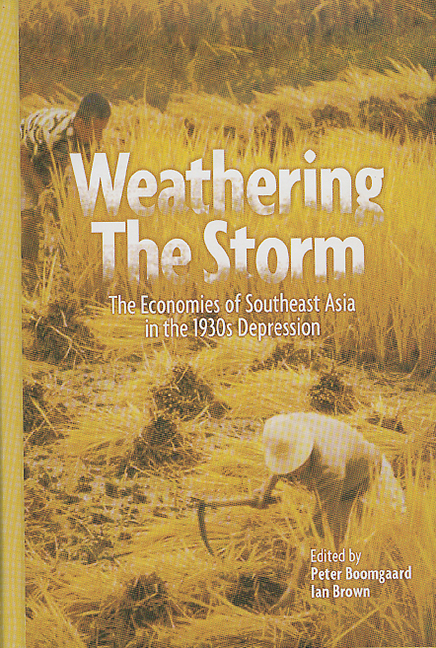Book contents
- Frontmatter
- Contents
- List of Tables
- List of Figures
- Acknowledgements
- List of Contributors
- 1 The Economies of Southeast Asia in the 1930s Depression: An Introduction
- PART I MATERIAL CONDITIONS
- PART II AGRICULTURAL STRATEGIES
- 6 Structural Origins of the Economic Depression in Indonesia During the 1930s
- 7 Entrepreneurial Strategies in Indigenous Export Agriculture in the Outer Islands of Colonial Indonesia, 1925-38
- 8 The Economy of Besuki in the 1930s Depression
- 9 The Rice Economy of Thailand in the 1930s Depression
- 10 Rice and the Colonial Lobby: The Economic Crisis in French Indo-China in the 1920s and 1930s
- PART III TRADING COMMUNITIES
- PART IV THE STATE'S RESPONSE
- Index
9 - The Rice Economy of Thailand in the 1930s Depression
from PART II - AGRICULTURAL STRATEGIES
Published online by Cambridge University Press: 21 October 2015
- Frontmatter
- Contents
- List of Tables
- List of Figures
- Acknowledgements
- List of Contributors
- 1 The Economies of Southeast Asia in the 1930s Depression: An Introduction
- PART I MATERIAL CONDITIONS
- PART II AGRICULTURAL STRATEGIES
- 6 Structural Origins of the Economic Depression in Indonesia During the 1930s
- 7 Entrepreneurial Strategies in Indigenous Export Agriculture in the Outer Islands of Colonial Indonesia, 1925-38
- 8 The Economy of Besuki in the 1930s Depression
- 9 The Rice Economy of Thailand in the 1930s Depression
- 10 Rice and the Colonial Lobby: The Economic Crisis in French Indo-China in the 1920s and 1930s
- PART III TRADING COMMUNITIES
- PART IV THE STATE'S RESPONSE
- Index
Summary
For much of the 1920s and 1930s, the world rice market was in turmoil: and this clearly had an important impact on the Thai economy, given that rice accounted for such a high proportion of the kingdom's exports and that the cultivation of rice was central to the livelihood of most Thais.
Disarray in Thailand's domestic rice market was clearly evident during the late 1920s. In one notable instance, in 1928 there was a dispute between some Chinese-operated rice mills and seven European export firms — the East Asiatic, Arakan, Borneo, Anglo-Siam, Steel Brothers, Windsor, and De Cooper Johnson — in which the latter sought to amend the terms of delivery and payment stipulated in their agreements. Originally, the export firms would pay for the rice when the miller bought it as paddy, and they accepted it for delivery at the mill. The exporters now proposed to pay the millers after delivery, and after inspection of the rice at their own warehouses. The proposal was not accepted by the rice millers. They pointed out the significant liability that could arise in the transportation of goods. A single shipwreck could result in a catastrophic loss for a rice mill. When the dispute could not be resolved, the seven firms ceased to purchase rice for export to Europe. Consequently, the export of Thai rice to Hong Kong and Singapore rose, but its price dropped sharply. This reduced the prices obtained by Thai farmers for their paddy. In the period from November 1927 to September 1928, the rice price in Hong Kong tumbled from HK$9.25 to HK$7.60 per picul, while in Singapore it fell from 9.25 baht to 8.25 baht per picul. As a result, paddy prices in Bangkok plunged by 15 baht per kwian (roughly one ton), or about 15 per cent, in just one month.
- Type
- Chapter
- Information
- Weathering the StormThe Economies of Southeast Asia in the 1930s Depression, pp. 189 - 197Publisher: ISEAS–Yusof Ishak InstitutePrint publication year: 2001

